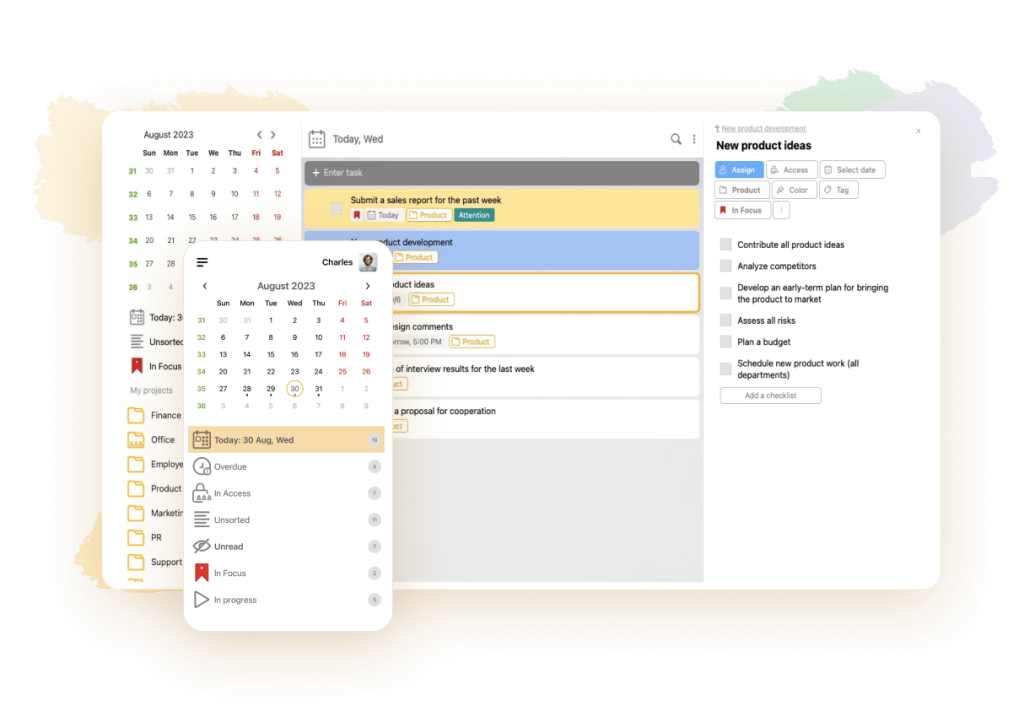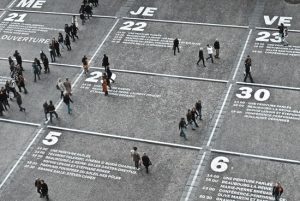Getting Things Done methodology in time management

In order not to drown with the head through an endless stream of daily routine, it is important to learn how to competently, manage their plans and tasks. Otherwise, there is always a risk of overlooking something important. Prepare for a meeting, organize a meeting, call a customer, make a monthly report by the end of the week. Also the child must be taken to the sports section, go to the hairdresser, drive the car for a checkup, do the cleaning in the house. From all these numerous cases, the head literally “goes round”. Because of this there is nervousness, everything falls out of hand. And at the moment when you need to concentrate and solve an important problem, in the head reigns chaos and despair. In such a state it is difficult to achieve the desired results. Disorganization is very slow in achieving goals in life and at work. How to get rid of this unpleasant disadvantage, suggests the popular time management methodology Getting Things Done.
What GTD is and how it works in practice
The author of the GTD technique is David Allen, an American business coach and project management consultant, and he invented the technique from scratch. The abbreviation of the name stands for: “Getting Things Done”, abbreviated GTD. The system was first described in his 2001 edition of the same name, which instantly became a worldwide bestseller. Thanks to its exceptional popularity, David Allen’s work has been translated into 23 languages. And the most famous magazine of the United States of America named the book “the best business publication of the 10th year”.
GTD technology is based on the following principles:
- Storing tasks, plans and to-do’s on external media (as entries in a notebook, agenda or electronic application).
- Using a clear structured system for planning.
The essence of the method lies in the fact that a person cannot achieve his goals because of information overload. In our head every day there is a huge number of different thoughts, tasks and other distractions that do not allow us to concentrate on the main thing. For this reason, Allen suggested not to try to keep all the information coming from the outside in the head, but to transfer it to external media in an organized, structured form.
Keeping daily records, planning, rational distribution of current and global affairs is an important quality of a modern manager or a successful person in life. Our brain is designed to generate, not store ideas. It is hard to disagree with this statement. After all, according to scientific research in the field of neuropsychology, a person can keep in his head simultaneously no more than seven tasks. And fully work with three of them.
By unloading your brain, you can deal with things from different areas of life faster. Using the GTD method, it is easier to manage tasks in work and in life. Since all important information will be concentrated in one place, it will be easier to keep track of it. This will help you get rid of stress and get your daily tasks in order.
This technique helps management and novices alike to understand the art of productive work. It is developed from years of experience and is one of the best time management techniques.
The difference between the GTD system and a regular to-do list
When we make to-do lists, we include the important, serious things, often leaving out the small and minor tasks. Because of this, they stay in our heads, distracting us from our main work. This leads to a decrease in efficiency. Following one of the main principles of the GTD method – to write down every step, helps to completely free the brain from minor tasks. Therefore, all its capabilities and resources can be utilized to perform important, responsible work.
In a normal to-do list, we know what needs to be accomplished, but we don’t know how to do it. GTD is different because in addition to knowing what needs to be done, we also know how to do it. With GTD, you can accomplish your tasks sooner and more efficiently. Also, one of the pros of gtd is that this system acts as a folder for all the tasks that need to be done. In your own system, you can customize some of the tasks or break them down into smaller tasks, making them easier to complete.
Who should use the Getting Things Done methodology

The author of the GTD method tested its effectiveness on ISS astronauts, rock musicians, and executives of large commercial companies. In all cases it showed positive results. That is, this system can be recommended to people of any age, social status or profession. The main criterion for its successful implementation in life is an analytical mind, a desire for self-organization and planning.
GTD time management is based on three basic models:
- Workflow Management.
- Six levels of reviews.
- Natural Planning.
Let’s consider each of them in more detail.
Task and case management in GTD
The case management process in Getting Things Done is divided into five phases:
- Gathering incoming information.
- Its sorting and processing.
- Working with lists.
- Review and organize lists.
- Task accomplishment.
How to collect information in GTD

To begin with, determine the place where the incoming information is stored. It can be any place that is convenient for you: an electronic application, a daily planner or an ordinary paper notebook. This item or device should always be at hand, so that you can quickly read and make corrections if necessary.
Get in the habit of writing down all information that comes to you at once, including ideas, tasks or projects. This will save you from having to keep all the plans, events or tasks in your head. And then, in the “sorting” phase, you will be able to make an educated and informed decision on each of them.
Processing stage
If you simply record everything on paper or digital media in a chaotic order, you run the risk of getting lost in an endless stream of things to do or losing sight of important tasks. Therefore, all data should be properly distributed and structured. The most convenient way to do this is with the help of a decision tree or a workflow diagram (according to Allen).
To properly assign tasks, ask yourself the following questions:
- What’s the point of the assignment?
- What is it supposed to accomplish?
- What actions must be taken to accomplish it?
- In what order will they be committed?
- How long will it take to complete the task?
Working with lists
The GTD case organization system consists of eight model lists:
| Projects | The following actions | Standby mode | Future plans | Calendar | Documents | Strategic goals | Project materials |
| Cases consisting of several tasks. For example, creating a website, renovating a bathroom, and so on. | Selected tasks and actions from the previous list, grouped by context. | Tasks that are not urgent. | Dreams, plans or expectations (traveling to France, attending design courses). | Tasks with a tight schedule that need to be completed by a certain deadline. | Important information, references, notes relevant to the project. | Used for long-term planning. | Graphs, charts, other information used to solve the tasks. |
Organizing and putting lists in order
In order to increase productivity and keep the system running, the lists created should be regularly reviewed and structured based on the priority of the tasks present in them. To do this:
- Reviewing the lists several times a day, complete step-by-step tasks from the Next Actions and Calendar items, noting their completion.
- New items are added to the Projects list or additional items are added to existing tasks.
- Review master lists once a week to keep them up to date.
Performing tasks on the GTD system

All of the actions described above are intended to make it easier to accomplish the tasks at hand. They are selected from a list of “Next Actions” based on importance, priority, time available for implementation, or other criteria. It is important to prioritize when you are sure of exactly what needs to be done to accomplish each task.
Levels of review
This model facilitates proper prioritization and alignment of current affairs with strategic plans.
| Current tasks | Filled out every day | This includes the daily tasks that need to be done during the day. For example: going to the store, contacting a customer, etc. |
| Current projects | Filled out every week | Tasks planned for the near future: dentist visit, moving to a new office. |
| Current responsibilities | To be filled out each month | This category includes job responsibilities, family responsibilities, household, creativity, and other areas of life. |
| Goals for 1-2 years | To be filled in every 3 months | Plans to be achieved by this period are indicated. |
| Targets for 3-5 years | To be completed each year | This item indicates possible global changes in your work or personal life. |
| All of life | Every year or less | This section answers questions of global scope: “What benefit does the company bring?”, “What is my main goal in life?”. |
The author of Getting Things Done, business coach David Allen, advises starting to write down to-do’s from the bottom level. That is, the formulation of current projects and cases. In this way, your head and mind will be free to develop and implement global projects.
The basics of natural planning
This module is used to make correct decisions on tasks. “Natural” planning is called because it works according to an algorithm identical to the decision-making mechanism of the human brain. It includes 5 stages:
- Setting goals and principles. Why am I doing this? What standards will I adhere to in order to achieve the goal?
- Projection of results. What should be the result at the end of the project?
- Brainstorming. Gathering any information, ideas, notes, tips for successful realization of the project.
- Planning to achieve the set goal with specification of stages, sequence of actions to be performed, priorities.
- Next Action. What should be done first? What are the next steps?
The natural planning model is suitable for individual and large-scale projects. The only differences will be in the detail of the processes. Allen argues that the detail of a project should be such that it can be completely out of your head.
Mistakes when working with the Getting Things Done methodology
Some novice users of the GTD methodology use its tools incorrectly. Managers unfamiliar with the methodology may find it overwhelming and confusing. Other common mistakes that occur when using the system include:
- Irregular review of lists and tasks.
- Unwillingness to “get used to” the new format for collecting and storing information.
- Collecting and storing important data in different locations.
- Vague, incorrect instructions for tasks in the Next Actions list.
- Holding information in your head, without committing it to an external medium.
- Multitasking.
By installing an app on your computer or phone or buying a diary, some people seriously expect the GTD system to work “by itself”. Putting things off until later will not achieve the desired results. So first of all, you need to start by changing your lifestyle and habits.
Popular services for working according to the GTD methodology: LeaderTask

One of the criteria for successful implementation of the Getting Things Done system is the convenience of keeping complete notes for daily and strategic planning. You can make them in a regular paper notebook or use the functional, modern LeaderTask application for this purpose.
The program is ideal for putting David Allen’s methodology into practice. Using the LeaderTask task manager, you can make to-do lists for each day without losing sight of any important event. Also, the application can be used to effectively manage any projects. The program will provide:
- Securely store information in one place.
- A convenient reminder system for upcoming events.
- Effective delegation of assignments to employees with follow-up.
- Sorting, structuring assignments into categories.
- Ability to add any information, files, documents to tasks.
LeaderTask app is suitable for all digital platforms. It works offline, without internet. It has a lot of cool features. You will always be aware of current and strategic tasks and can regularly monitor their fulfillment.
Conclusion
In order to properly apply the GTD methodology for organizing work on projects, you need to accustom yourself to recording every task and action on an external medium. Develop the habit of getting rid of unnecessary information that prevents you from concentrating on important processes. Think through what the end result will be. This will save energy and time to achieve it, and will eliminate anxiety due to uncertainty.
Planning your project activities will help you achieve your goals faster. No project can be completed in one sitting. It is broken down into individual tasks, taking small steps to help you move toward the main goal.
Online resources such as use cases and a comprehensive guide help to enhance this approach. But there are downsides – introducing this technique can be difficult for beginners and takes time to work out the details.
However, GTD is a great approach to time management that can help you become more efficient and have more time.
Using GTD methodology, it is easier to find appropriate methods for each task. The main thing is to regularly review the compiled lists, perform the tasks present in them, guided by your professional and personal experience and common sense.



